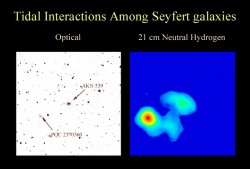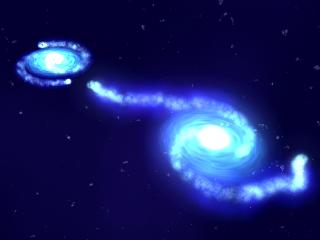Seyfert galaxies appear to be normal spiral galaxies, but they have fluctuating bright centers. And now, their deep-down, hidden nature has been revealed: they are cannibals. While visible-light images didn’t provide much evidence that these galaxies had any interaction with their neighbors, radio-telescope images from the Very Large Array revealed that Seyfert galaxies are snacking on neighboring galaxies, with the “meal” feeding the supermassive black hole at their centers. Astronomers had suspected this was the case, but until now, they didn’t have the evidence to support the idea.
One leading theory said that the fluctuations seen in Seyfert galaxies’ centers were caused by close encounters with neighboring galaxies. The gravitational encounters stirred up gas from the neighboring galaxies and brought it within reach of the black hole. However, when astronomers looked at Seyferts with visible-light telescopes, only a small fraction showed any evidence of such an encounter. Now, new images of hydrogen gas in Seyferts made using the National Science Foundation’s Very Large Array (VLA) radio telescope show the majority of them are, in fact, disturbed by ongoing encounters with neighbor galaxies.
“The VLA lifted the veil on what’s really happening with these galaxies,” said Cheng-Yu Kuo, a graduate student at the University of Virginia. “Looking at the gas in these galaxies clearly showed that they are snacking on their neighbors. This is a dramatic contrast with their appearance in visible starlight,” he added.
The effect of the galactic encounters is to send gas and dust toward the black hole and produce energy as the material ultimately is consumed. Black holes, concentrations of matter so dense that not even light can escape their gravitational pull, reside at the cores of many galaxies. Depending on how rapidly the black hole is eating, the galaxy can show a wide range of energetic activity. Seyfert galaxies have the mildest version of this activity, while quasars and blazars are hundreds of times more powerful.

The astronomers picked a number of relatively nearby Seyfert galaxies that had previously been observed with visible-light telescopes. They then carefully studied the Seyferts with the VLA, specifically looking for radio waves emitted by hydrogen atoms. The VLA images showed the vast majority of the Seyferts were disturbed by encounters with neighbor galaxies.
By comparison, similar VLA images of inactive galaxies showed that very few were disturbed. “This comparison clearly shows a connection between close galactic encounters and the black-hole-powered activity in the cores,” said Ya-Wen Tang, who began this work at the Institute of Astronomy & Astrophysics, Academia Sinica (ASIAA), in Taiwan and now is a graduate student at the National Taiwan University.
“This is the best evidence yet for the fueling of Seyfert galaxies. Other mechanisms have been proposed, but they have shown little if any difference between Seyferts and inactive galaxies,” Tang added.
Original News Source: National Radio Astronomy Observatory


Again it should be emphasized that many QSOs, BL Lacs & blazars appear to be in interacting systems, although their higher luminosities can make detection of companion extremely difficult.
Hmm . . . how can a galaxie perhaps as little as a couple hundred thousand light years in diameter have a center that fluctuates in brightness on a time scale that we can detect? It defies logic.
I don’t understand why black holes would take material from neighboring galaxies but leave the stars in their own galaxy untouched. I say untouched because they are all still there or it would not be a galaxy. So how does it suck in gas from neighboring galaxies but not consume much closer stars?
Yeah, it does make no logical sens. I thought the galaxy itself moved not that material from the neighbouring galaxy moved towards the black hole, what about the material close to the blackhole, isn’t it ‘consumed’ as well?
The smaller of the two galaxies in the photo may be the larger and more than a few light years apart. Is Tang sure one galaxie is feeding off the other?
If this is a gravitational interaction, why does the material make a huge half circle in extending from one galaxy to another?
Maybe the motion of the “local” stars around the black hole is sufficient to generate enough centripetal force to keep them from being sucked in.
AstroNOMNOMNOMy!
Sorry, just couldn’t resist. 🙂
great LOL!
“joe Says:
June 23rd, 2008 at 11:28 pm ”
@Joe, @ anne
It should be emphasized that these black holes are not actually taking material from the other galaxy. Rather, the gravitational interactions of the two galaxies disturb the equilibrium ‘orbits’ of material already encircling the black hole, which causes it to begin spiraling in and getting consumed.
“Chuck Lam Says:
June 24th, 2008 at 5:47 am ”
@Chuck Lam
This is a great point – in fact, it is this very line of evidence that provided the original strong evidence that these object are powered by black holes, and not some other mysterious phenomenon.
If you think about it, no information can travel faster than the speed of light. Hence, if we see variability on timescales of say, a day, we just use the very simple relation distance = velocity_of_light*time to give us and estimate of the maximum expanse of the light emitting region, in this case, one light-day. There is only one known object that can power such luminous variability that we know of, and that object is a supermassive black hole at the centre of the galaxy!
erm .. wow !
The more I learn the more I get confused !
Thanks for the reply. It does make more sense now.